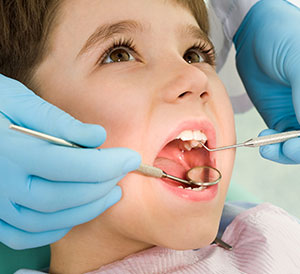Dental Care For Children

Fractured Milk Teeth: Milk tooth fracture can occur in the root or Crown of the tooth. This may involve the enamel, enamel and dentine and in some cases, it might also involve the pulp of the tooth.
The rough edges of enamel fractures can be covered by smoothing them. In a case of an enamel-dentine fracture, the crown of the tooth should be restored to protect the nerves of the tooth. If the fracture affects the pulp of the tooth, your dentist will analyse the stage of development of the milk tooth, and then decide if it needs to be extracted. In some other cases, a Root canal treatment is carried out.
Milk Teeth Decay: Tooth decay in infants and toddlers is known as “baby bottle tooth decay”. Baby bottle tooth decay occurs when sweetened liquids or any food with natural sugars (like milk, formula, and fruit juice) remain in the infant’s teeth for a prolonged period. Bacteria in the mouth feed on this sugar and form acids that slowly affect the teeth. Giving the infant a sugary drink at night can be harmful because the flow of saliva decreases while sleeping.
Mouth Guards: A mouthguard is a device used for the protection of the teeth and gums preventing them from injury. A mouthguard helps avoid injuries caused due to sports, a treatment for bruxism, dental procedures like tooth bleaching.
Many sports organisations have now made it mandatory that participants use mouth guards during the game to protect traumatic injuries. Even though mouth guards are designed to protect the teeth and gums from injury, they can also reduce the degree of pressure from a trauma impact to the jaw, reaching the central nervous system (base of the brain). Mouth guards help minimise the risk of brain injury, which is very important for younger children.
Mouth guards also reduce the possibility of the following injuries:
- Cheek lesions
- Concussions
- Neck injuries
- Gum and soft tissue injuries
- Tongue lesions
- Jawbone fractures
- Lip lesions
- Tooth fractures
Happy Gas: Nitrous Oxide, commonly known as laughing gas (Happy Gas), is a mild sedative for children who may be overly nervous or anxious about their dental treatment. Nitrous Oxide helps to calm a child’s fear of the dental treatment.
The sedative is delivered through a nose mask which has nitrous oxide mixed with oxygen. It is given to the patient while breathing in and out. The patient is asked to breathe normally through the nose, and the gas takes effect while the breath is inhaled. The child becomes relaxed as a result. Nitrous Oxide is 100% safe to use on children during treatment and can be quickly eliminated from the child’s body immediately on turning the gas off. Children usually remain awake during the entire procedure and will be able to interact and with the dentist while being treated.
Retainers: A retainer is a crucial part of Orthodontic treatments. Retainers are made of metal wire and plastic. The metal wire surrounds the six anterior teeth helping to keep them in place. The advantage of using retainers is that the metal wire can be adjusted to finish the orthodontic treatment and continue movement of the anterior teeth as required.
Habit breaking appliances: Habit breaking appliances are used to wean the child off some habits that can cause misalignment of teeth. These habits may include:
- Lip biting
- Tongue thrusting
- Nail biting
- Thumb sucking
Habit breaking appliances work in the modification of the child’s teeth growth properly. There are a variety of habit breaking appliances, each with a different property and use. But in case your child has any of these habits, the result of using these appliances may benefit your child in the long run.
Some of these habit breaking appliances are:
- Blue Grass Appliance
- Habit Crib
- Hayrake
- Lip Bumper
- Myofunctional Bead
- Fixed Expander with Loops
- Removable Habit Appliance
Diet and Snacking
What foods are healthy for my child?
A balanced diet which naturally supplies all the essential nutrients that your child needs to grow is considered to be healthy. A balanced diet includes the following foods: Fruits, Vegetables, Grains Meat, Breast Milk. Breast milk is a source of nutrients that build your child’s immunity and makes them strong enough to fight infections.
How does diet affect my children’s dental care?
Children must have a balanced diet for their teeth to grow properly. A balanced diet also contributes to the healthy growth of tissue around the teeth. Importantly, a diet high in certain, a type of carbohydrates) such as sugar and starches, may put your child at the risk of developing cavities and Tooth decay.
How can I make my children’s diet safe, and in line with good paediatric dental care?
Firstly, it is essential to be sure that your child has a healthy diet. Also, check how frequently they eat sugar-based or starchy foods. Foods high in starch include bread, crackers, pasta and fried snacks. A variety of sugar-based foods contain one or more types of sugar, and these types of sugars can lead to dental decay. Fruits, vegetables, and most milk products have at least one kind of sugar present in them.
Most processed foods have sugar including many that do not taste sweet. Sugar is added to most condiments such as ketchup and salad dressings.
Should I restrict all sugary foods for the sake of my children’s dental care?
Certainly not! Many of these sugary foods provide nutrients which your child needs. Your challenge is to the right kind of sugar-based foods, and feed them to your children wisely. Food which is high in sugar or starch should ideally be given to children along with meals, and not as snacks. This will help in enhancing your child’s dental care. Chewy foods like dried fruits or caramelised toffees etc., are hard to be washed away from the teeth by the saliva, water or milk. Hence, there is more potential for causing cavities. Talk to your paediatric dentist who can help you select and serve foods that protect your child‘s dental care.
Does a paediatric dentist assure that a balanced diet can provide enough fluoride, which is vital in paediatric dental care?
No. A balanced diet does not guarantee the amount of fluoride your child may get. But if you do not live in a fluoride-rich area, you might have to provide your child with some fluoride supplements during the growing years of your child, which sees a lot of tooth development. Your paediatric dentist can help you assess how much supplemental fluoride your child requires, based on the how much fluoride is present in your drinking water, and other potential sources of fluoride.
My baby has still not started eating solid foods yet. Do you have any suggestions for healthy paediatric dental care?
Do not nurse the little one to sleep or let him sleep with a bottle of milk, formula, juice or any sugary liquids. Doing this may leave unswallowed liquid in the mouth, which feeds bacteria that produce acids in the mouth. These acids react with the teeth enamel and attack the teeth. The bacteria slowly eats up the affected teeth causing severe teeth decay.
Any final advice?
Yes. Here’s a list of tips for diet corrections for your children’s dental care.
- Check with your paediatric dentist for how to assess your child’s diet.
- Shop smartly! Do not overstock your pantry with sugary or starchy snacks for your child. Fun foods can occasionally be given.
- Limit the frequency of snack times, make better choices of nutritious snacks.
- Do not put your child to bed with a bottle of milk, juice, or formula.
Common Questions About Fluoride in Paediatric Dental Care
Why do children need fluoride?
Fluoride is an essential mineral for all children. Our mouths contain bacteria that combine with sugars in the food we eat and beverages we drink to produce acid. The acid that is produced harms the tooth enamel resulting in damaging the teeth. Fluoride protects the teeth by making them more acid resistant and also help reverse early signs of teeth decay.
Toothpaste that we use every day has a right amount of fluoride in it. Do we still need fluoride in the water we use?
Yes. Usually, for many people, brushing with fluoridated toothpaste may not be enough. Drinking fluoridated water throughout the day bathes our teeth inadequate levels of fluoride, to keep the teeth healthy. This combined with more concentrated fluoride in dental care products, prevent more tooth decay than with toothpaste alone. This makes it essential to make sure if your children are drinking fluoridated water and if they are brushing correctly with fluoride-rich toothpaste at least twice a day.
What does dental fluorosis mean? Is it related to drinking fluoridated water?
Dental fluorosis refers to the change that occurs in the appearance of the teeth, which are in the form of very faint white marks. It is not easy to detect with the naked eye, and your paediatric dentist is the right person who can identify it. Most of the times fluorosis does not affect the function of the teeth or overall dental health. In fact, teeth affected by mild fluorosis are more resistant to cavities. Most fluorosis is the result of consuming too much fluoride while teeth are forming, before the age of 8.
Facts About Dental Sealants In Paediatric Dental Care
Did you know?
70% of children are affected by tooth decay by the age of 19. Untreated tooth decay results in pain & infection. Fluoride in toothpaste and drinking water protects the smooth surfaces of teeth, but back teeth need extra protection. They need dental sealants.
What are dental sealants?
One highly effective way to prevent cavities is dental sealants. Dental sealants are a thin plastic film painted on
The chewing surface of the teeth. Most of the cavities start in the pits and grooves of a child’s newly erupted teeth. Food and germs get stuck in the grooves of teeth. Bacteria in the mouth use the sugar in food to make acids. Over time, the acids can cause a cavity in the tooth. Sealants help by keeping germs and food out.
When should dental sealants be placed?
Children should get sealants on their molars (back teeth) as soon as they come in. In this way, sealants can protect the teeth through the cavity-prone ages of 6 to 14 years old.






